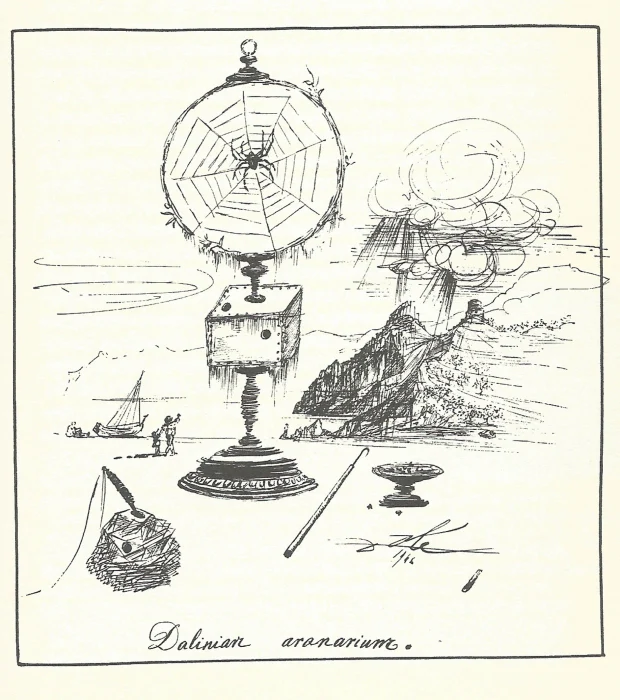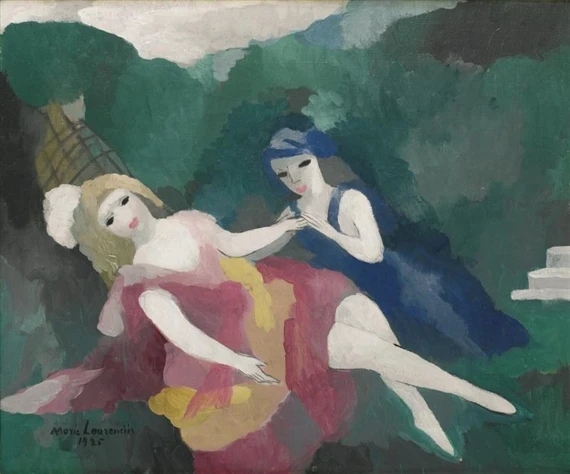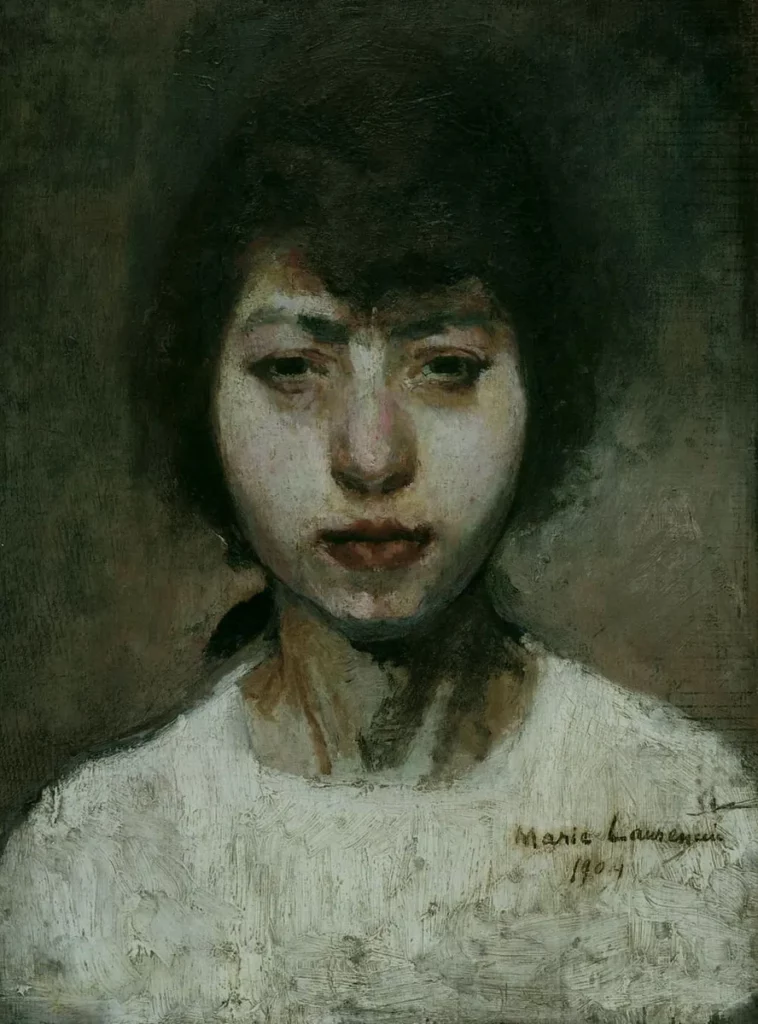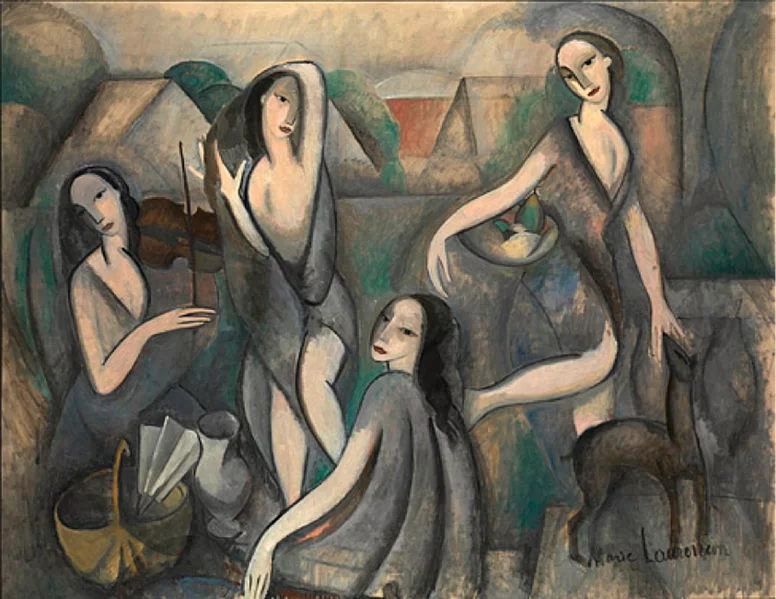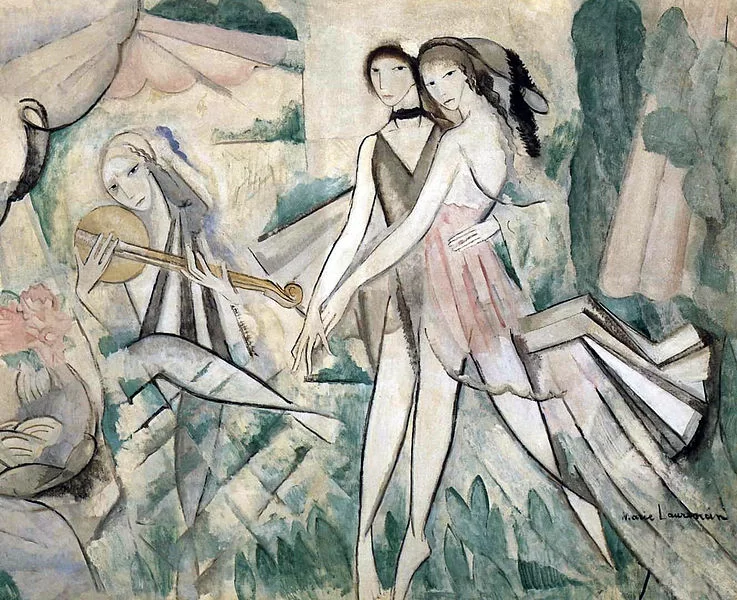Happy Friday the 13th! Whether you think it’s unlucky or not, we got a Friday the 13th in October this year and that makes my favorite month even more special! To celebrate, I picked out 13 dark and creepy paintings. From explorations of the taboo to dealing with trauma, these artists created masterpieces that will send chills up your spine!
Saturn Devouring His Son – Francisco Goya
You’ve probably seen this one before. No? Search for dark, creepy paintings and Saturn Devouring His Son will be one of the first to pop up.
Toward the end of his life, Goya moved into a villa outside Madrid. He painted its walls with a series of works known as his “Black Paintings”. None of the paintings were named by Goya and they were not intended to be viewed by the public. It wasn’t until after the paintings were removed from the walls and transferred to canvas that they were named for their subjects.

Francisco Goya. Saturn Devouring His Son. 1819 – 1823.
Saturn was painted in the dining room, and depicts the Roman god Saturn eating one of his children after being told that one of them would overthrow him. The deity appears consumed by madness while he tears into his victim. It’s been interpreted as a representation of time consuming all things, the inescapability of God’s wrath, and the conflict of old age and youth. Some scholars question whether this is a depiction of Saturn at all, since the usual references to this story are absent.
This famously dark and gory painting made by a man in his twilight years, with its limited palette and loose composition, masterfully captures a moment of an insatiable hunger driven by fear.
The Nightmare – Henry Fuseli
I remember seeing this one in college, but not much else. Either we didn’t spend much time on The Nightmare or I wasn’t paying attention… Still, it’s an image that stays with you. What is that creature sitting on that poor lady and why is he looking at us? Whose nightmare is this anyway? And what’s up with that horse?

Henry Fuseli. The Nightmare. 1781.
The creature is an incubus – “a type of spirit said to lie atop people in their sleep or even to have sexual intercourse with sleeping women.” The title of the painting suggests it may also reference a “mare”, a mythological being known to suffocate or torture people in their sleep. The woman’s pose and vulnerability coupled with the presence of the incubus add a layer of sexuality to the painting that was considered scandalous at the time, yet the piece was popular enough that Fuseli painted other versions.
But what about that horse? It wasn’t in the drawings Fuseli did before the actual painting. It’s not a pun on the title, but may reference some other elements of folklore. Other interpretations say the horse peeking through the curtains confirms the sexual nature of the woman’s nightmare – on full display for the viewer.
The Face of War – Salvador Dali
You can’t have a list of weird art without Dali being on it. His work takes you places that you wouldn’t find on your own and in some cases make you wonder if you really want to be there. The Face of War depicts a face contorted in fear, reflected again and again within itself. Snake slither around the outside and a single handprint (Dali’s) marks the lower right corner.

Salvador Dali. The Face of War. 1941.
The Face of War was painted during the brief time Dali lived in California. He fled to the United States at the start of WWII after the Germans took France. This happened just after he spent 1936-1939 in Paris to escape the Spanish Civil War. War deeply impacted his life and it’s no surprise he chose to depict the horrors and trauma caused by it.
Girl with Death Mask (She Plays Alone) – Frida Kahlo
I had teachers throwing Kahlo lessons around from Junior High through college and not once did this painting come up. It’s like they just want to teach The Broken Column and move on. Girl with Death Mask is believed to be a self-portrait of Kahlo at age four. The mask is similar to those worn in celebration of the Day of the Dead and the flower she holds is likely an offering for a grave.

Frida Kahlo. Girl with Death Mask (She Plays Alone). 1938.
The girls stands in a desolate landscape, perhaps suggesting that in the end we all die alone. Her youth stands in contrast with the theme of death – something we prefer to associate with old age. Whether or not the painting is autobiographical is up for debate, but Kahlo was no stranger to pain and ill-health and death is a theme she often played with.
The Severed Heads – Theodore Gericault
Most figure painters worked from live models, or at least used them as references. So what did an artist use to paint severed heads? And why? In Gericault’s case, he used actual severed heads. He also painted other body parts and corpses, but it wasn’t a macabre series that led him to paint them. The Severed Heads is one of several painting studies in preparation for a larger piece.
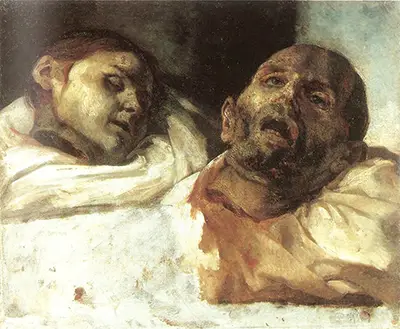
Theodore Gericault. The Severed Heads. 1818.
At the Paris Salon in 1819, Gericault presented the gasp-inducing Raft of the Medusa, which depicted aftermath of a shipwreck. This included the survivors and detailed renderings of the casualties. So even though there are no mythological connections are or symbolic meanings to his studies of body parts and corpses, the fact that they are meant to directly represent a real human tragedy adds a layer of real-life horror.
Death and the Miser – Hieronymous Bosch
You may know The Garden of Earthly Delights, but did you know about this one? Bosch’s art overall was pretty out there, perhaps making him a surrealist ahead of his time. The Garden of Earthly Delights was a triptych (a three-panel painting) and Death and the Miser was part of one too.

Hieronymous Bosch. Death and the Miser. ca. 1490.
This painting is a deathbed scene, where the miser is tempted with gold by a demon under his bed and an angel implores him not to give in – all while death waits at the door. Themes of good and evil pervade the composition and allude to the corrupt life the miser led.
The Ghost of a Flea – William Blake
Can you imagine every insect that dies leaves a ghost behind? Do you need a soul to become a ghost after you die? Does that mean fleas have souls?? Luckily that’s not what The Ghost of a Flea is about.

William Blake. The Ghost of a Flea. ca. 1819.
There’s a lot going on in this little (8.42″x6.3″) painting, which is based on a vision that Blake had at a seance in 1819. The flea, a grotesque humanoid figure, is a symbol of greed and filth. He carries a bowl of blood in his left hand and a thorn in his right, framed by curtains and stars. The monstrous form is dark, evil – and according to what it told Blake it is the manifestation of bloodthirsty men.
Big Electric Chair – Andy Warhol
What is Andy Warhol doing on this list?? His work was colorful and bold! What’s creepy about soup cans? Big Electric Chair is actually part of a series by Warhol where he juxtaposed bright colors over the dark imagery of the chair.

Andy Warhol Big Electric Chair. 1967.
The image itself is a cropped press photograph of the electric chair at Sing Sing prison, which had been used for the last time in 1963. The series as a whole calls out the exploitation of tragedy in the media while it “emphasizes the pathos of the empty chair waiting for its next victim.”
The Flaying of Marsyas – Titian
Titian is a big name in Renaissance art, but this isn’t one of the paintings they usually teach. In Greek mythology there was a satyr named Marsyas who challenged the god Apollo to a musical contest. The Flaying of Marsyas depicts the scene after the satyr lost.

Titian. The Flaying of Marsyas. ca. 1570.
As Apollo skins Marsyas alive, a cute little dog laps up his blood and another satyr brings a bucket into the gruesome scene. The scene is one of agony, suffering, and the delight of those who inflict it.
Skull of a Skeleton with Burning Cigarette – Vincent Van Gogh
This isn’t what typically comes to mind when you think of Van Gogh, but as an artist he went to some dark places – both in life and in paint. Skull of a Skeleton with Burning Cigarette is actually one of his earlier works and was painted as a joke while he was attending classes at the Royal Academy of Fine Arts in Antwerp.

Vincent Van Gogh. Skull of a Skeleton with Burning Cigarette. 1886.
It was common practice for students to study the human skeleton to learn about anatomy and proportion, but Van Gogh wanted to express vibrance and life with his art. Adding the cigarette to the skeleton was his tongue-in-cheek way of giving a little life to his study.
Dante and Virgil – William-Adolphe Bouguereau
Before we get into this painting, can we just stop to appreciate the expression on the demon in the background? He’s just having his own moment back there. If there’s a character anywhere in this blog that needs a caption, it’s this demon. (Note to self: spend a whole post writing stuff for this background demon!)
Bourguereau was not known for painting dark compositions like Dante and Virgil. He was trying to win an art competition, so he chose a scene from Dante’s Divine Comedy, which happened to be a favorite topic of one the judges (he still didn’t win).

William-Adolphe Bouguereau. Dante and Virgil. 1850.
In this scene, Dante and Virgil watch a brutal fight between two damned souls. The trickster Gianni Schicci savagely bites into the neck of the heretic Capocchio as other souls suffer the tortures of Hell in the background. However, what eclipses all of the pain and agony of this scene is that fact that no one talks about that demon.
Death of Marat – Jacques-Louis David
Here’s another big one from college! Jean-Paul Marat was a French revolutionary leader and friend of the artist. Marat was assassinated in his home by a political enemy, leading David to capture the event in his painting, Death of Marat.

Jacques-Louis David. Death of Marat. 1793.
Marat suffered from a skin condition that left him spending much of his time in the bathtub – so much that he often worked there. The assassin gained entrance to Marat’s home with a note promising useful information. Once inside, she stabbed him. Thus we see Marat, bleeding in the tub with a note in his hand and the murder weapon on the floor.
Screaming Pope – Francis Bacon
We’ve talked about Francis Bacon before and this is the same one – the artist, not the philosopher. While this painting is often referred to as the Screaming Pope, the title is Study after Velázquez’s Portrait of Pope Innocent X. Generally Bacon didn’t paint from life and didn’t take commissions, which freed him from any obligation or consideration of painting a “respected” figure in a favorable light. This is probably why he chose Velasquez’s Pope paintings to base his own on – even for a commission Velasquez favored realism over flattery.

Francis Bacon. Screaming Pope. 1953.
Bacon was so taken with Velasquez’s pope paintings, that he painted his own series for over 20 years. He claimed it was the only place he could use this color palette. All of his popes are boxed in, screaming or close to it. Some critics believed the series was Bacon’s way of dealing with issues with his father, which the artist brushed off. Bacon said the popes were rather his way of surpassing Velasquez.
With only 13 paintings for Friday the 13th we obviously couldn’t get to all the wonderfully dark paintings out there. So tell me, which ones did I miss? What are your favorites? Let me know in the comments!














